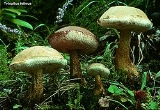
Tylopilus felleus
Encyclopedia
Tylopilus felleus, formerly Boletus felleus, is a fungus
of the bolete family
, found in Northern Europe and North America. Although it is not poisonous, it is not considered edible, due to its overwhelming bitterness.
in 1788. It derives its specific name from the Latin
fel meaning "bile" referring to its bitter taste, similar to bile
.
A subspecies in the Great Lakes region, var. uliginosus, was recognised by Smith and Thiers
in 1971.
is grey yellow to pale brown. It is slightly downy at first, but is later smooth. The stalk
is lighter, and covered with a coarse brown network. Like most boletes it lacks a ring, and it may be distinguished from Boletus edulis
by its unusual pink pores. The flesh is white or creamy, and pink beneath the cap cuticle. The pores bruise brownish, and it gives a pink to vinaceous spore print
.
and coniferous woodland, often under beech
and oak
. Occurring in well drained acid soils, from August to September, in many of the northern temperate zones.
Fungus
A fungus is a member of a large group of eukaryotic organisms that includes microorganisms such as yeasts and molds , as well as the more familiar mushrooms. These organisms are classified as a kingdom, Fungi, which is separate from plants, animals, and bacteria...
of the bolete family
Boletaceae
Boletaceae are a family of mushrooms, primarily characterized by developing their spores in small pores on the underside of the mushroom, instead of gills, as are found in agarics. Nearly as widely distributed as agarics, they include the Cep or King Bolete , much sought after by mushroom hunters...
, found in Northern Europe and North America. Although it is not poisonous, it is not considered edible, due to its overwhelming bitterness.
Taxonomy
The species was first described in the scientific literature as Boletus felleus by Jean Baptiste François Pierre BulliardJean Baptiste François Pierre Bulliard
Jean Baptiste François Pierre Bulliard was a French physician and botanist....
in 1788. It derives its specific name from the Latin
Latin
Latin is an Italic language originally spoken in Latium and Ancient Rome. It, along with most European languages, is a descendant of the ancient Proto-Indo-European language. Although it is considered a dead language, a number of scholars and members of the Christian clergy speak it fluently, and...
fel meaning "bile" referring to its bitter taste, similar to bile
Bile
Bile or gall is a bitter-tasting, dark green to yellowish brown fluid, produced by the liver of most vertebrates, that aids the process of digestion of lipids in the small intestine. In many species, bile is stored in the gallbladder and upon eating is discharged into the duodenum...
.
A subspecies in the Great Lakes region, var. uliginosus, was recognised by Smith and Thiers
Harry D. Thiers
Harry Delbert Thiers, born January 22, 1919 in Fort McKavett, Texas, died August 8, 2000 in Ohio, was an American mycologist who studied and named a great many fungi of native to North America, particularly California. Thiers taught mycology at San Francisco State University for many years, and a...
in 1971.
Description
Up to 15 cm wide, the capPileus (mycology)
The pileus is the technical name for the cap, or cap-like part, of a basidiocarp or ascocarp that supports a spore-bearing surface, the hymenium. The hymenium may consist of lamellae, tubes, or teeth, on the underside of the pileus...
is grey yellow to pale brown. It is slightly downy at first, but is later smooth. The stalk
Stipe (mycology)
thumb|150px|right|Diagram of a [[basidiomycete]] stipe with an [[annulus |annulus]] and [[volva |volva]]In mycology a stipe refers to the stem or stalk-like feature supporting the cap of a mushroom. Like all tissues of the mushroom other than the hymenium, the stipe is composed of sterile hyphal...
is lighter, and covered with a coarse brown network. Like most boletes it lacks a ring, and it may be distinguished from Boletus edulis
Boletus edulis
Boletus edulis, commonly known as penny bun, porcino or cep, is a basidiomycete fungus, and the type species of the genus Boletus. Widely distributed in the Northern Hemisphere across Europe, Asia, and North America, it does not occur naturally in the Southern Hemisphere, although it has been...
by its unusual pink pores. The flesh is white or creamy, and pink beneath the cap cuticle. The pores bruise brownish, and it gives a pink to vinaceous spore print
Spore print
thumb|300px|right|Making a spore print of the mushroom Volvariella volvacea shown in composite: mushroom cap laid on white and dark paper; cap removed after 24 hours showing pinkish-tan spore print...
.
Distribution and habitat
It grows in deciduousDeciduous
Deciduous means "falling off at maturity" or "tending to fall off", and is typically used in reference to trees or shrubs that lose their leaves seasonally, and to the shedding of other plant structures such as petals after flowering or fruit when ripe...
and coniferous woodland, often under beech
Beech
Beech is a genus of ten species of deciduous trees in the family Fagaceae, native to temperate Europe, Asia and North America.-Habit:...
and oak
Oak
An oak is a tree or shrub in the genus Quercus , of which about 600 species exist. "Oak" may also appear in the names of species in related genera, notably Lithocarpus...
. Occurring in well drained acid soils, from August to September, in many of the northern temperate zones.
External links
- Tylopilus felleus by Robert Sasata, Healing-Mushrooms.net, February, 2008.

